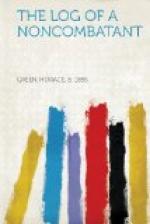Merely for what they may be worth, and not in any sense as conclusive, I mention the cases which came to my attention. During a month spent in that part of Belgium where the most savage of the atrocities were reported,—a month devoted to a diligent search for the truth,—I could run down only two instances where the facts were proved, and where taken all in all and looked at from both sides they constituted an atrocity. I lived in an atmosphere of popular apprehension frequently amounting to terror. A friend of mine saw children throw up their hands in terror and fall down on their knees before a squad of German Uhlans who suddenly dashed into a village near Vilvorde. The incident does not prove that Uhlans are in the habit of acting atrociously; it does prove the popular fear of them. Near the same town I investigated the case of a peaceful villager, reported in the current conversation of the story to have had his ears cut off and to have been finished off with a half-dozen bayonet wounds. This I got at first hand from the man who had seen the body. I asked him how he knew the man had been bayoneted by Germans. My informant said that he himself was running from the village, where a skirmish was going on between a regiment of the enemy (Germans) and Belgian carabineers, that he was racing for his life through a rain of bullets, etc., etc., and that under fire of sharpshooters he stumbled across this body. He did not know the man was dead; but the case interested him. So later he went back (still under fire of the sharpshooters) and counted the number of holes in the man’s shirt; there were six, he told me, and he was sure from the shape of the holes that they were the result of bayonets, not bullets.
At one time when driving from Ghent toward Brussels with Julius Van Hee, the acting Consul-General of the United States at Ghent, we passed a little hillock of ground upon which was a small square slab of stone, topped by a pair of sticks—hardly more than sticks—in the shape of a cross. There was a yarn floating around the neighborhood, which had almost crystallized into legend, that this was the fresh grave of a child murdered by the Germans because it refused to salute. They said the feet had been cut off and the boy was left to bleed to death. Conceivably the story was true. We did not stop, for we could not carry the investigation to the point of digging up a fresh grave.




